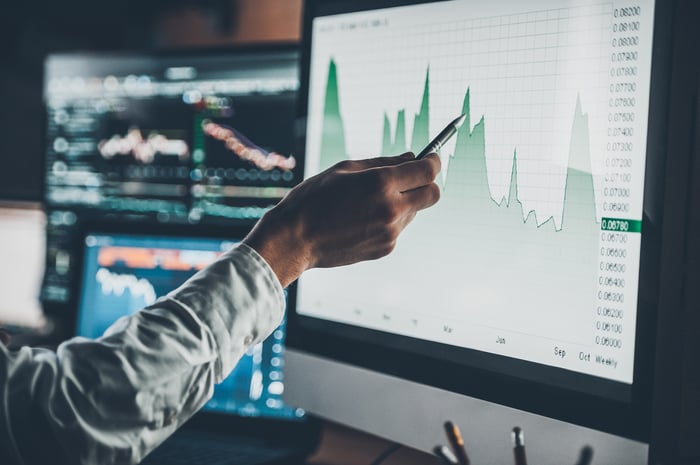Royal Dutch Shell (RDS.B) is one of the world's largest integrated energy companies. But the company in the future isn't going to look like it has over the past, say, 100 years or so. That may be a good thing, but are the changes taking shape today enough to make it worth going along for the ride as Shell revamps its business?
A difficult year
It would be a massive understatement to suggest that 2020 was a hard year for energy companies. The coronavirus pandemic drastically reduced demand for oil and natural gas as economies around the world effectively shut down in an attempt to slow the spread of the novel illness. On top of that, the global supply of oil was high heading into the year thanks to years of growth in U.S. energy production. Lots of supply and little demand led to a steep decline in energy prices. It got so bad at one point that a key U.S. oil benchmark fell below zero.

Image source: Getty Images.
That was an unprecedented event, though there were technical reasons for the drop and the subzero pricing was brief. Still, it shows how hard a year 2020 was for companies that produce oil and natural gas. So, in some ways, it's understandable that Shell made the very difficult decision to cut its dividend by 66%. There were, however, bigger picture reasons for this decision that need to be taken into consideration.
Where to from here?
There's no question that Shell's dividend cut was a blow to investors enticed by its long history of rewarding income-focused investors with consistent dividends. However, it might have been the best call the company could have made. For starters, Shell is looking to reduce its leverage, so freeing up cash that would otherwise go toward dividends will help in that effort. In addition, the exploration and production business is highly capital intensive, with the company planning to maintain capital spending in the $20 billion space annually over the near term. Once again, reducing the dividend should help.
The key here, however, is that the spending plans Shell is undertaking are a bit different this time around. While it isn't giving up on oil, it is going to focus exclusively on its best assets and look to sell lesser ones. Management's goal is to reduce capital spending in the upstream space from around 40% of the total in 2020 to between 25% and 30% by 2025. Transition businesses, which include natural gas and chemicals, will stay at around 40% of spending. And growing from roughly 15% of capital outlays to between 35% and 40% will be growth businesses, which include renewable power and the company's marketing operations.
The shift from oil to renewables is really the big story here, as it shows that Shell is attempting to shift along with the world around it. And after cutting the dividend, it has set a target of growing the dividend by 4% a year in the future. It has already made good on that promise, with a dividend increase of exactly that size in the third quarter of 2020. Although the current yield of around 3.5% isn't huge compared with energy industry peers that haven't resorted to dividend cuts, there are still reasons to like the income story here.
For starters, the S&P 500 index is only offering a dividend yield of around 1.5% today. So, Shell's yield is, relative to the broader market, pretty enticing. And the plan for ongoing dividend growth, even at a modest 4%, is nice to see, as was the quick move to act on that commitment. Meanwhile, 4% annual growth actually exceeds the historical rate of inflation growth, which is around 3% or so. Thus, Shell's plans will slowly increase the buying power of the dividend over time.
RDS.B Dividend Yield data by YCharts
And all of that is backed by a company that's looking to use its cash cow energy business to support a shift toward cleaner alternatives. Equally important, the transition here will help ensure that Shell remains a viable entity over the long term. It's hard to argue with that goal or the need for such change, given the increasing importance of environmental issues in the world today. Essentially, 2020 should be looked at as a reset year for Shell.
Is it worth buying?
Investors looking to maximize income will find there are more attractive options in the energy sector right now, including Total, which is making a similar business shift but has chosen to maintain its dividend. Maintaining the dividend, however, is not growing the dividend. And that could be the differentiating factor that gets some investors interested in Shell as it works to shift toward clean energy. Notably, ExxonMobil and Chevron have higher yields and are still committed to dividend growth, but they aren't working as hard to transition toward a cleaner future.
It's difficult to suggest that Royal Dutch Shell is a screaming buy, since there's a lot of work ahead and success is far from certain. And yet, so far, Shell is following through on the plan it set out to do (notably including its first dividend increase). Meanwhile, with oil prices back up around pre-pandemic levels, the company will have more leeway to maneuver as it seeks to reposition its business. That's not a terrible story, though it may not be a great one, either. Conservative investors with a focus on dividend growth over yield might want to dig in here, but perhaps only if they are specifically looking to add an integrated giant in the energy space.






